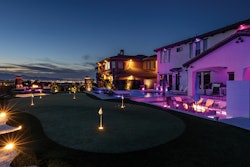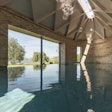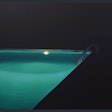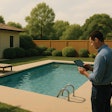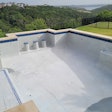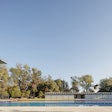
Hydroxyl radicals exist for only a tiny fraction of a second. The reason for their extreme brevity is simple: hydroxyl radicals are remarkably reactive. So reactive, in fact, that they are far more potent as an oxidizer than chlorine gas, ozone or hypochlorous acid; that makes them well suited for oxidizing disinfection byproducts.
Hydroxyl radicals are so short lived, however, they are still only part of the water treatment picture, but their power is being harnessed to improve sanitation in pools and spas.
AOP takes place in a variety of ways. It can even occur naturally in the atmosphere. But for the purposes of our industry, it is generated by electrolytically combining UV and ozone.
According to Ray Denkewicz, global product manager, sanitization and chemical automation for Hayward Industries, "Microbial inactivation studies employing a combination of UV and ozone have been reported for decades in water treatment. These studies have been made almost exclusively in non-swimming pool applications, and so less notice may have been taken of them within the pool and spa industry."
RELATED: All About Alkalinity
He continues: "Aqueous ozone absorbs UV radiation at wavelengths of 200 to 310 nm, and in turn, decomposes to form hydrogen peroxide. Hydrogen peroxide then further reacts with UV to produce hydroxyl radicals. The reaction pathway also suggests that hydrogen peroxide, when added to a UV system, would provide a similar benefit in the production of hydroxyl radicals. For this reason, hydrogen peroxide/UV systems and hydrogen peroxide/ozone/UV systems are used for many water treatment applications where oxidation is a primary objective."
Although still relatively obscure to many in the pool and spa industry, the power of AOP reactions has been widely studied.
"The synergistic action, has been attributed to the formation of hydroxyl radicals when UV light interacts with ozone," Denkewicz says. "The potent nature of hydroxyl radicals results in what is effectively a one-two-three punch when UV and ozone are used together."
A GOVERNMENT ASSIST
Already a growing market in the pool and spa industry, the use of ozone, UV and AOP systems received a huge boost in August 2014 with the publication of the CDC's Model Aquatic Health Code, a vast 600-plus page document that covers a wide range of technical and management issues for commercial facilities. Among the voluntary standards published in the MAHC, the CDC recommends the use of secondary sanitation and oxidation, or secondary "pillars" of chemical treatment, specifically ozone and/or UV systems with small chlorine residuals.
On the oxidation side of the recommendation, the CDC recognized problems associated with sanitization byproducts, such as respiratory ailments for people using indoor pools. By keeping the chlorine residual to a minimum and further oxidizing its byproducts, improving water quality.
Beyond that, however, concerns over recreational water illnesses — particularly cryptosporidium, perhaps the most notorious and hearty pathogens found in pools and spas — further prompted the CDC to turn to ozone and UV tandems, largely because the two technologies generate AOP, which effectively kills crypto, which in effect protects bathers — particularly elderly, children and those with compromised immune systems — from severe intestinal problems.
Widespread illnesses stemming from cryptosporidium outbreaks have received a tremendous amount of attention in recent years, but the effectiveness of the ozone/UV/AOP trio has also been widely established across a number of other pathogen species.
In 2015, Denkewicz published a series of academic articles in Water Quality Products Magazine in which he cited an important study that looked at the combination's ability to kill E. coli, another tremendously problematic and more common pathogen.
RELATED: Alternative Sanitizers + Chlorine: The Quest For Synergy
"A landmark study published in 2006 by Magbanua, et al., clearly and systematically delineated the synergistic effect of a UV/ozone combination against E. coli," he says. At first, the researchers studied the efficacy of UV and ozone against E. coli in separate, independent tests.
"In doing so," he continues, "the team was able to establish the requisite dosages of each disinfectant to affect a specific level of microbial reduction. In a second series of tests, the team utilized UV and ozone together to determine if the resulting microbial reduction was simply the sum of the contributions from each disinfectant. The results were nothing short of astounding. It was discovered that the individual UV and ozone doses required to destroy E. coli to the same extent (e.g., 99.9 percent) could be reduced by factors of 18 and 4, respectively, when the two disinfectants were used together."
He also points out that according to the study, the synergy generated by UV/ozone water treatment is attributed to the presence of supplemental hydroxyl radicals. "That is to say, the observed results were greater than the expected contributions of their parts."
Greater oxidation power than the sum of its parts — an excellent summary of AOP.
Process DefinitionSo what does "oxidation" actually mean? Here's a trip back to basic chemistry. In a 1973 study by researchers Dorfman and Adams, oxidation is defined as the transfer of one or more electrons from an electron donor (reductant) to an electron acceptor (oxidant), which has a higher affinity for electrons. "These electron transfers result in the chemical transformation of both the oxidant and the reductant, in some cases producing chemical species with an odd number of valence electrons. These species, known as radicals, tend to be highly unstable and, therefore, highly reactive because one of their electrons is unpaired. Oxidation reactions that produce radicals tend to be followed by additional oxidation reactions between the radical oxidants and other reactants (both organic and inorganic) until thermodynamically stable oxidation products are formed." AOP systems involve these two stages of oxidation: 1) the formation of strong oxidants (e.g., hydroxyl radicals) and 2) the reaction of these oxidants with organic contaminants in water. |
Comments or thoughts on this article? Please e-mail [email protected].



























